4.1.1 The Creation of a Sign Born Out of One Line
Written by Petra Stokar
Student MA Art Education, Hochschule der Künste, Bern
Drawings by Petra Stokar - 24. December 2012
What is drawing?
That is a question that deserves to be answered as questions always do,
Henri Matisse searched for an answer on this question too,
the power of drawing in a minimalistic way,
express yourself, just draw what you have to say,
don’t wait and do it now,
the drawing will come out somehow,
simplicity, leave away what you don’t need,
don’t think of things that can go wrong, don’t think of your defeat,
a single line is all you need,
in the world of dreams there is no wright or wrong,
just like the follow up in words that compose a song,
or take a scissor with which you can draw in the same way,
create your own world which you can change every day.
Enjoy your freedom.
Poem by Petra Stokar - February 2013

This poem demonstrates the power of a minimalistic drawn sign in which a picture is created with a minimum of effort. That is what I have learned studying the material of Matisse. It is also something that I experienced while working with the Alexander Technique, but with Matisse it is explained in a very direct way.
He is giving different possibilities to start drawing, to start by imagining one in the position of ones subject. Or start by coping a drawing that is seen in order to get the image in ones body.
One is able feel the skeleton of the real animal that is being created, feeling with one hand, draw what is felt with the other or draw what ever comes up with your eyes closed. Not to worry about the details, just drawing the outline of the subject and only using four lines to draw a face with character.
When Matisse draws he does not draw only what he sees, but also he expresses the emotion that it evokes in him together with his thoughts and feelings. An example of this is a quote from Matisse himself:
«I have shown you, haven’t I, the drawings I have been doing lately, learning to represent a tree, or trees? As if I’d never seen or drawn a tree. I can see one from my window. I have to learn patiently, how the mass of the tree is made, then the tree itself, the trunk, the branches, the leaves. First the symmetrical way the branches are disposed on a single plane. Then the way they turn and cross in front of the trunk...
Don’t misunderstand me: I don’t mean that, seeing the tree through the window, I work at copying it. The tree is also the sum total of its effects upon me. There’s no question of my drawing a tree that I see. I have before me an object that effects my mind not only as a tree but also in relation to all sorts of other feelings...»1
Danza Mobile Spain
When I read this my thoughts drifted away to Spain and they landed at the school of Danza Mobile. Suddenly I made a connection, if a sign, because that is what a drawing is according to Matisse, is a combination of that what the senses take in and the feelings and thoughts that the drawing provokes in them, could it then be that while a student was drawing, a thought was arising in him while his hand was doing something else. Matisse had this very often but he became aware of that after his own reflection on his work, and in talks with Louis Aragon. Aragon writes:
«The painter (Matisse) speaks to me, once more, about something which has never ceased to worry him: when he first outlined the composition of his drawing for Mallarmé’s Les Fleurs, he did it with lilies, but when he came to the final work he unconsciously substituted for these an equal number of different flowers, recognised by him as white clematis, and certainly a ten-year-old memory of a hedge of white clematis he had seen for several successive summers and which at the time had seemed to him inimitable.
And now they suddenly blossomed in the etching, quite perfect, with something about them of the utmost elusive delicacy, as if they had dropped from the stars. . . Isn’t that what Mallarmé meant : the flower he had smelled as a child . . . engrafted in the blue watermark of the soul? This is what Matisse asks in somewhat different terms : ‘Isn’t a drawing the synthesis, the climax, of a series of sensations which the brain has retained and gathered together, (...).»2
For while working with people with down syndrome, I found out that it may appear that for some peoples reflection is a difficult thing, because their strength and power is to live in the here-and-now. While teaching I often experience that they don’t remember anymore what they had worked on the previous day. You have to repeat what you had taught the previous day again.
I don’t mean to say that forgetting something is negative, I find it the biggest strength of down syndrome people because they see what they have created every day in a new light. That is what Matisse says: as an artist you have to learn, to empty your mind from all memories from things that have been drawn before.
An example of being hindered by creating something new by previous memories is demonstrated in the following quote:
Le Bouquet. Dans une promenade au jardin je cueille fleur après fleur pour les masser dans le creux de mon gras l’une après l’autre au hasard de la cueillette. Je rentre à la maison avec l’idée de peindre ces fleurs.
Après en avoir fait un arrangement à ma façcon quelle déception: tout leur charme est perdu dans cet arrangement. Qu’est-il donc arrive?L’assemblage inconscient fait pendant la cueillette avec le gout qui m’a fait aller d’une fleur à l’autre est remplacé par un arrangement volontaire sortir de reminiscences de bouquets morts depuis longemps, qui ont laissé dans mon souvenir leur charme d’alors dont j’ai chargé de nouveaux bouquet.
Renoir m’a dit: «Quand j’ai arrange un bouquet pour le peindre, je m’arrète sur le côté que je n’avais pas prévu.» 3
English translation: (by Mathias Roth)
The Bouquet. On a walk in the garden I am picking flower after flower to massage one after the other in the pit of my belly fat - at a random gathering. I returned home with the idea of painting these flowers.
After having made an arrangement in my own way – what a disappointment: all their charm is lost in this arrangement. What has happened? The assembly unconsciously made during this harvest, with the taste that made me go from one flower to another, is replaced by a voluntary arrangement coming out of my memory of bouquets that are dead a long time ago, who have left in my memory their charme with which I have charged this new bouquet.
Renoir told me: "When I arrange a bouquet to paint it, I stop myself on the side I did not expect."
Reading signs differently
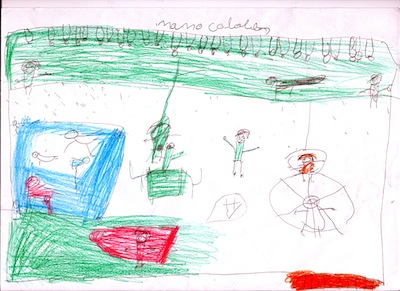
Now let us go back to the signs in which we started of this chapter.
The drawing in my book «Make the Set Design of Life» that depicted a swimming pool and above it was in written words: « The Red Hand».
Could this be the reason why the title and the picture did not fit together. Could it even be that the sign that we have for three in the world of down syndrome people totally means something else. Could it be that down syndrome interpret their own signs or create their own signs that are new and fresh and not recognised yet by society.
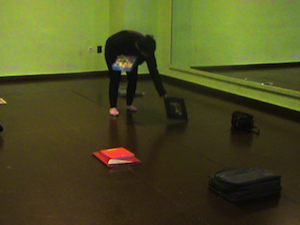
Here a quote from Matisse: «The importance of an artist is to be measured by the number of new signs he has introduced into the language of art...».
Another example of reading signs differently as society does it, is the film that I made from a student that made her own set design with many books and pillows spread over the whole stage. When we asked her what she had created she said that it was the universe.
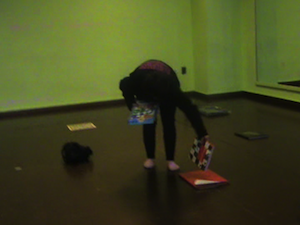
Something which was totally surprising us. Matisse also creates his pictures with the minimum of lines, he demonstrates this in the following quote: «But follow the stroke that encircles the cloud, see how amazingly the artist’s thought informs the slender line, which expresses all the yearning for the boat that will come.»4
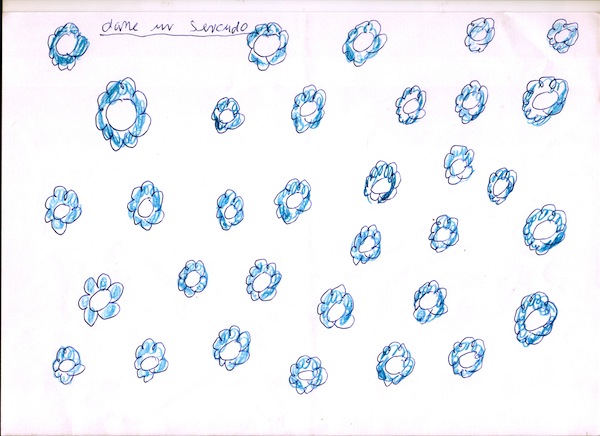
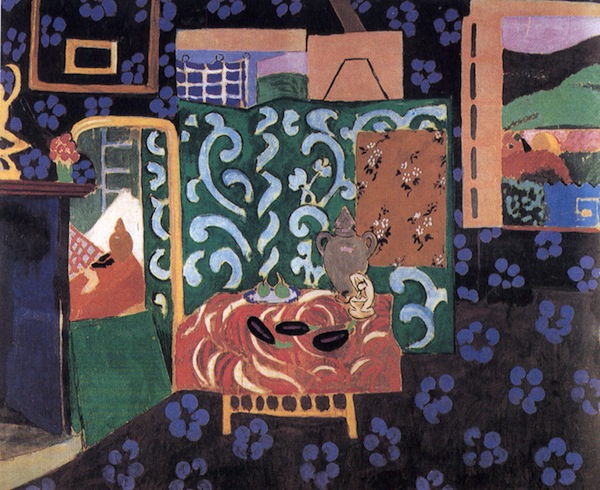
This is the famous painting «Interior with Eggplants» which is created in Collioure in the year 1911. Louis Aragon, one of France’s foremost poets, comments it in “Henri Matisse, a Novel:
«And although from 1908 onwards he began a new sort of painting, (...) works which only in a wider sense can be considered as Fauve, yet Fauvism persists throughout Matisse’s work. Perhaps it was rekindled by a visit to Sevilla in 1911. Of the major works of this period I have chosen here the Large Studio and Interior with Eggplants. (...) It is absurd, of course, to look for any demarcation line for Fauvism in Matisse’s work.»5
This picture of Matisse was striking to me. For suddenly I recognised the drawing of one of the Danza Mobile students: «Give me a second», where blue flowers where drawn in a random pattern. Could these flowers be eggplants? Maybe it is possible that Matisse was in Sevilla inspired by eggplants. After online research I found out that eggplants are growing in Sevilla and that they are a national dish in that region. Maybe this Danza Mobile student was drawing this same common vegetable: an eggplant?
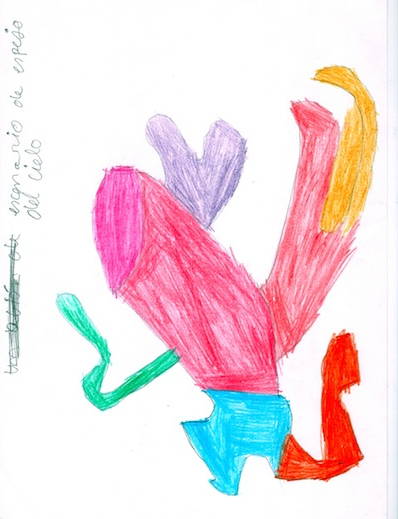
Fauvism is the style of les Fauves (French for «the wild beasts»), a group of early twentieth century Modern artists, whose works showed strong colour over the representational or realistic values retained by Impressionism. While Fauvism as a style began around 1900 and continued beyond 1910, the movement as such lasted only a few years, 1904-1908, and had three exhibitions. The leaders of Fauvism were André Derain and Henri Matisse.6
Primary Inspiration was found in the works and teachings of Gustave Moreau, leading the École des Beaux-Arts in Paris.7
An example of this fauvinistic style can be found in the drawings of a student of «Danza Mobile» called the «Set Design of the Mirror of the Sky». It is a drawing that is created with the minimum of lines but the colours are representing the powerful feelings of the student.
-
1 «Henri Matisse: a novel» by Louis Aragon. Translated by Jean Stewart 1972 / Original 1971 – Page 109 / 110 ↩
-
2 «Henri Matisse: a novel» by Louis Aragon. Translated by Jean Stewart 1972 / Original1971 – Page 129 ↩
-
3 «Henri Matisse, Fascimile of the illustrated book Jazz» by Henri Matisse 2009 Originally published in 1974 by Editions Teriade, Paris. Publisher Taschen Gmbh 2009 – Page 30 ↩
-
4 «Henri Matisse: a novel» by Louis Aragon. Translated by Jean Stewart universe.1972 / Original 1971 – Page 12 ↩
-
5 «Henri Matisse: a novel» by Louis Aragon. Translated by Jean Stewart 1972 / Original 1971 – Page 301 ↩
-
6 «The “Wild Beasts,??? Fauvism and its Affinities» by John Elderfield„ 1976, Museum of Modern Art – Page 13 ↩
-
7 «The Fauve Landscape» by Judi Freeman et al., 1990, Abbeville Press, Page. 243 ↩





